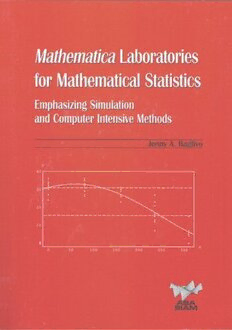
Mathematica Laboratories for Mathematical Statistics: Emphasizing Simulation and Computer Intensive Methods PDF
281 Pages·2004·30.119 MB·English
Most books are stored in the elastic cloud where traffic is expensive. For this reason, we have a limit on daily download.
Preview Mathematica Laboratories for Mathematical Statistics: Emphasizing Simulation and Computer Intensive Methods
Description:
Integrating computers into mathematical statistics courses allows students to simulate experiments and visualize their results, handle larger data sets, analyze data more quickly, and compare the results of classical methods of data analysis with those using alternative techniques. This text presents a concise introduction to the concepts of probability theory and mathematical statistics. The accompanying in-class and take-home computer laboratory activities reinforce the techniques introduced in the text and are accessible to students with little or no experience with Mathematica. These laboratory materials present applications in a variety of real-world settings, with data from epidemiology, environmental sciences, medicine, social sciences, physical sciences, manufacturing, engineering, marketing, and sports. Mathematica Laboratories for Mathematical Statistics: Emphasizing Simulation and Computer Intensive Methods includes parametric, nonparametric, permutation, bootstrap and diagnostic methods. Chapters on permutation and bootstrap techniques follow the formal inference chapters and precede the chapters on intermediate-level topics. Permutation and bootstrap methods are discussed side by side with classical methods in the later chapters.
See more
The list of books you might like
Most books are stored in the elastic cloud where traffic is expensive. For this reason, we have a limit on daily download.
